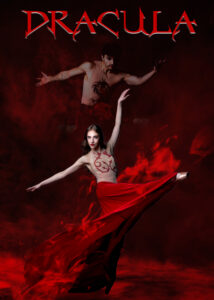Dracula

Still seducing audiences today, the original vampire’s legend of immortal love lives on in this extraordinary ballet. Sensuous dancing and powerful theatre are enhanced by haunting projections and sultry costumes. A suspenseful gothic tale to an incredible score.
BUYER BEWARE
The RMTS is the only authorized seller for Ballet Victoria performances at the Royal Theatre. Any other websites offering tickets for sale are resellers and they are not authorized to sell. If you purchase through a reseller you run the risk of the tickets being invalid, being sold in another currency and being charged above market value. Remember, if you buy from a reseller, the RMTS will not able to troubleshoot or assist you with ticketing issues as the RMTS did not sell the tickets.
Behind the Curtain
TICKETS: Starting at $34.00.
On the RMTS website, subscription package seating is automatically assigned within a selected price category. If you desire specific seats, you must call the RMTS box office at 250-386-6121 to reserve.
VENUE: Royal Theatre, 805 Broughton Street
DATES:
Friday, March 15 at 7:30PM
Saturday, March 16 at 7:30PM
Sunday, March 17 at 2:00PM
“…the Count turned his face, and the hellish look that I had heard described seemed to leap into it. His eyes flamed red with devilish passion: the great nostrils of the white aquiline nose opened wide and quivered at the edge; and the white sharp teeth, behing the full lips of the blood-dripping mouth, clamped together like those of a wild beast.”
– Dracula, Bram Stoker
In the fifteenth century, Count Vlad Dracula defends Transylvania against the Turks, only to face despair upon the false news of his death and the tragic suicide of his wife, Elizabeth. Rejected by the clergy for burial, Dracula renounces God and humanity, transforming into a cruel vampire.
Fast forward to 1897 London, where young solicitor Jonathan Harker finalizes Dracula’s mysterious estate purchase in England. Before he leaves, he and his fiancée Mina visit the hospitable home of Mrs Westenra to say goodbye to their friends. The hostess, who has a heart condition, is being courted by the eccentric Professor Van Helsing. Her vivacious daughter Lucy is being wooed by two friends: aristocrat Arthur Holmwood and psychiatrist Doctor Jack Seward. Lucy is more favourably inclined towards Arthur. Meanwhile, her friend Mina is filled with serious misgivings about Jonathan’s departure for a distant country. Bidding him farewell, she offers her beloved a decorative likeness of herself, and then confesses her sadness to Lucy.
As the tale unfolds the narrative shifts between Transylvania and London, the unsettling obsession of Renfield, a character marked by peculiar madness and a desperate desire for immortality, Lucy’s engagement, and the tragic fate that befalls her. The climax intensifies with Dracula’s pursuit of Mina, leading to a dramatic confrontation and a poignant resolution that intertwines love, sacrifice, and the eternal struggle between light and darkness.
Dracula author Bram (Abraham) Stoker (1847 – 1912) was an English civil servant, actor and theater manager. He began his writing career with a somewhat dry-sounding government manual (The Duties of Clerks and Petty Sessions in Ireland) as well a few short stories. He published his first novel in 1890 and soon began researching European folklore and stories about vampires He published Dracula seven years later.
Dracula is told in a series of gripping diary and journal entries, ship log entries, telegrams and newspaper articles written by the main characters. Count Dracula, a vampire from Transylvania (the central part of present-day Romania), travels to Great Britain in a quest to find new blood and spread the undead curse. A young British lawyer, imprisoned in Dracula’s castle as the novel opens, escapes the clutches of Dracula’s brides at the castle, and journeys back to England. He leads a small band, including his fiancée, a professor and a doctor, to track Dracula down, chase him back to Transylvania, and finally kill him.
It is thought that Stoker ran across the name Dracula in his research for the book. Dracul (meaning dragon) was the clan name of 15th-century Romanian ruler Vlad II. His son, Vlad III (Dracula, or son of Dracul), was also known as ‘Vlad the Impaler,’ who is said to have brutally killed tens of thousands of invading Ottoman Turks by impaling them on stakes set in Romanian forests. At the last minute before publication, Stoker substituted the more alluring Dracula for the original name he’d chosen for the character (Count Wampyr). He also changed the title from The Un-Dead to Dracula.
When Dracula was published in 1897 it was well-received but it wasn’t a blockbuster: readers and reviewers saw it as not much more than an entertaining horror story. Dracula didn’t reach legendary status until it was adapted for movie versions in the 20th century. The vampire image that Stoker created would become the definitive vampire across the globe.